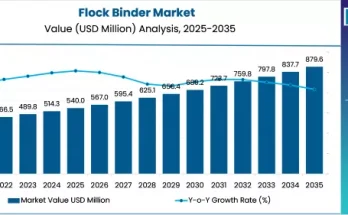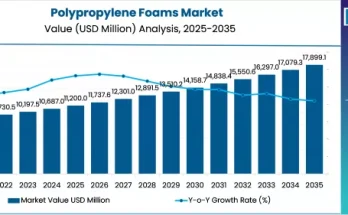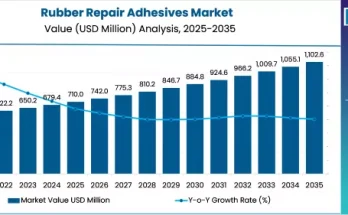Market Forecast: Sustained Growth Through 2035
The global wetting and dispersing agents market is expected to achieve steady long-term growth. Valued at USD 9.8 billion in 2025, it is projected to reach USD 17.9 billion by 2035. This expansion reflects a compound annual growth rate of 6.2 percent during the forecast period. Rising adoption across industries such as coatings, adhesives, construction, inks, and agrochemicals is driving this growth. Increasing awareness of performance efficiency, combined with evolving regulatory frameworks and the demand for eco-friendly formulations, positions the market for a sustained upward trajectory.
Recent Developments and Innovation Drivers
Sustainability has become a cornerstone of innovation within this sector. Leading players are rolling out low-VOC and bio-based dispersants that align with environmental standards while maintaining excellent performance. Companies have also been actively launching advanced dispersing technologies that improve pigment compatibility and enhance stability in complex formulations. For example, polymeric dispersants, bio-based surfactants, and reactive additives are gaining prominence for their ability to meet both regulatory requirements and customer expectations.
Another notable trend is the emphasis on securing raw materials and strengthening supply chains. Major industry participants are making strategic investments in upstream feedstock supplies, ensuring consistent access to essential intermediates such as silicone and polymer precursors. This move helps safeguard production capacity while mitigating risks from global supply chain disruptions.
Market Overview by Segment
The wetting and dispersing agents market is segmented across multiple dimensions that highlight its diverse applications and growth potential. Formulation technologies form a critical part of this segmentation, with solvent-based systems, water-based systems, high-solids systems, and UV-curable systems serving as the primary categories. Beyond formulation technology, the market is further classified by type, source, material type, application, and end-use industry. In addition, regional segmentation provides a clearer picture of how demand is evolving across North America, Europe, Asia-Pacific, Latin America, and the Middle East and Africa. This level of granularity allows businesses to identify opportunities within specialized areas and align their product development or investment strategies accordingly.
Competitive Landscape
Competition in the wetting and dispersing agents market is intense, with a mix of multinational corporations and regional specialists vying for market share. Leading companies such as BASF, Clariant, Evonik, Dow, Arkema, BYK, Solvay, Croda, Huntsman, and Elementis continue to shape industry direction. These organizations are adopting strategies that revolve around product innovation, sustainability, regional expansion, and raw material security.
BASF’s development of plant-based dispersants exemplifies the industry’s growing focus on eco-conscious products. Meanwhile, companies like BYK and Allnex are investing in feedstock security to ensure cost efficiency and long-term competitiveness. Many players are also building region-specific research and development centers to tailor solutions for local customer needs and regulatory requirements. This combination of sustainability, innovation, and localization is a key differentiator in the current competitive environment.
Regional Trends and Segment Highlights
Water-based systems currently dominate the formulation technology segment, accounting for more than half of total market share in 2025. This reflects the widespread shift toward eco-friendly, low-VOC alternatives, especially in developed markets where regulatory scrutiny is stricter. High-solids and UV-curable systems are also gaining momentum due to their performance advantages in automotive, electronics, and industrial applications.
In terms of regional growth, India is emerging as the fastest-growing market, with a forecast compound annual growth rate of approximately 7.5 percent through 2035. The country’s expanding construction, automotive, coatings, and textile industries are fueling demand. Other parts of Asia-Pacific, particularly China, Japan, and South Korea, are also experiencing robust uptake of advanced dispersants, with Japan and South Korea standing out in electronics and specialty coatings.
North America is witnessing rising demand for high-solids systems due to stringent environmental regulations. Europe, led by Germany, continues to transition toward solvent-free and eco-labeled dispersants, particularly in coatings and printing applications. Latin America is seeing demand growth through construction activities, while the Middle East and Africa are gradually adopting advanced systems driven by sustainability initiatives and industrial development.
Challenges and Headwinds
Despite the optimistic outlook, several challenges remain. One of the most significant hurdles is formulation complexity. Since dispersing agents must interact effectively with pigments, binders, and substrates, universal solutions are difficult to achieve, requiring continual customization. Regulatory pressure also adds to the challenge, as manufacturers must reformulate products to meet ever-stricter standards on emissions and toxicology.
Another headwind lies in the high costs of research and development. Developing specialty dispersants involves significant investment and often long validation timelines, which can slow down commercialization. Fragmented global regulations and supply chains create additional barriers to smooth market expansion. Finally, many end-users remain cautious about adopting advanced formulations due to concerns about cost implications and potential risks to performance, leading to resistance against transitioning away from legacy systems.
Conclusion
The wetting and dispersing agents market is set for a decade of steady growth, expanding from USD 9.8 billion in 2025 to USD 17.9 billion by 2035, with a compound annual growth rate of 6.2 percent. This growth trajectory is underpinned by demand for eco-friendly solutions, high-performance dispersants, and regulatory compliance across multiple industries.
Sustainability and innovation are emerging as decisive themes, with leading players focusing on low-VOC and bio-based formulations, advanced polymeric dispersants, and regionalized research capabilities. At the same time, competitive strategies such as securing raw materials and strengthening global supply networks are proving essential in maintaining resilience against volatility.



